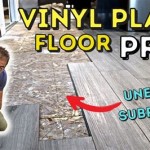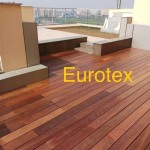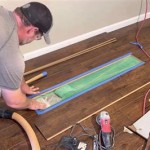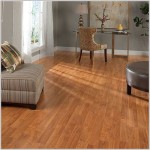Home Vinyl Flooring: A Comprehensive Guide
Home vinyl flooring represents a versatile and increasingly popular flooring option for a wide range of residential spaces. Its durability, cost-effectiveness, and aesthetic adaptability have contributed to its prevalence in modern homes. This article aims to provide a comprehensive overview of home vinyl flooring, covering its various types, advantages, installation considerations, and maintenance requirements.
Vinyl flooring, in its essence, is a synthetic flooring material composed primarily of polyvinyl chloride (PVC). This composition grants it inherent properties such as water resistance and resilience. Over the years, manufacturing advancements have significantly enhanced the quality and appearance of vinyl flooring, allowing it to closely mimic the look and feel of more expensive materials like hardwood, stone, and tile. These improvements have further solidified its position as a viable alternative for homeowners seeking a balance between cost and aesthetics.
The evolution of vinyl flooring is a story of continuous innovation. Early iterations were often perceived as less desirable due to their limited designs and perceived lack of durability. Modern vinyl flooring, however, benefits from advanced printing techniques and enhanced wear layers. This evolution has resulted in products that offer a greater variety of styles, improved resistance to scratches and stains, and longer lifespans. The current market offers a diverse selection of vinyl options to suit various budgets and design preferences.
Types of Home Vinyl Flooring
The term "home vinyl flooring" encompasses several distinct types, each exhibiting its own unique characteristics and installation methods. Understanding these differences is crucial for selecting the most appropriate vinyl flooring for a specific application.
Sheet Vinyl Flooring: Sheet vinyl is sold in large, continuous rolls, often 6 or 12 feet wide. This format minimizes the number of seams, making it particularly well-suited for spaces prone to moisture, such as bathrooms and kitchens. The installation process typically involves adhering the sheet to the subfloor with an adhesive. Sheet vinyl offers a cost-effective and water-resistant flooring solution, although it may be more challenging to install than other vinyl options, requiring precise measurements and careful handling to avoid bubbles or wrinkles.
Vinyl Tile Flooring: Vinyl tiles are individual squares that are adhered to the subfloor. They offer greater design flexibility compared to sheet vinyl, allowing for patterns, borders, and custom layouts. Vinyl tiles are generally easier to install than sheet vinyl, as they can be cut and placed individually. They are available in a wide range of colors, patterns, and textures, making them suitable for various design styles. However, the presence of seams between the tiles can make them slightly less water-resistant than sheet vinyl.
Luxury Vinyl Tile (LVT) and Luxury Vinyl Plank (LVP): LVT and LVP represent premium vinyl flooring options that closely mimic the appearance of natural materials. LVT replicates the look of stone or ceramic tile, while LVP replicates the look of hardwood planks. These products typically feature a thicker wear layer and more realistic textures than standard vinyl tiles or planks. LVT and LVP often incorporate a click-lock installation system, which allows for a floating floor that does not require adhesive. They are known for their durability, water resistance, and aesthetic appeal, making them popular choices for homeowners seeking a high-end look at a more affordable price point.
Wood-Plastic Composite (WPC) Vinyl Flooring: WPC vinyl flooring features a core made from a combination of wood flour and plastic. This core provides enhanced dimensional stability and water resistance compared to traditional vinyl flooring. WPC flooring is often thicker and more rigid, which can make it more comfortable underfoot. It is also less prone to expanding and contracting with temperature changes, making it suitable for installation in areas with fluctuating temperatures or high humidity. WPC flooring is typically installed using a click-lock system.
Stone-Plastic Composite (SPC) Vinyl Flooring: SPC vinyl flooring features a core made from a combination of limestone and plastic. This core provides exceptional rigidity and dent resistance. SPC flooring is even more resistant to water and temperature changes than WPC flooring. It is often chosen for high-traffic areas or homes with pets or children. SPC flooring is also typically installed using a click-lock system and can sometimes be installed over existing hard surface floors with minimal subfloor preparation.
Advantages of Home Vinyl Flooring
The popularity of home vinyl flooring stems from its numerous advantages, making it a compelling choice for homeowners considering various flooring options.
Durability: Vinyl flooring is known for its resilience and ability to withstand heavy foot traffic, scratches, and stains. The wear layer, a protective coating applied to the surface of the vinyl, plays a crucial role in its durability. Thicker wear layers offer greater protection against wear and tear, making them ideal for high-traffic areas. This durability translates to a longer lifespan for the flooring, reducing the need for frequent replacements.
Water Resistance: One of the most significant advantages of vinyl flooring is its inherent water resistance. Unlike hardwood or laminate flooring, vinyl is impervious to water, making it suitable for use in bathrooms, kitchens, laundry rooms, and basements where moisture is likely to be present. This water resistance prevents water damage, mold growth, and other issues associated with moisture exposure. The seamless nature of sheet vinyl further enhances its water resistance, making it an excellent choice for areas requiring maximum protection.
Cost-Effectiveness: Vinyl flooring is generally more affordable than many other flooring options, such as hardwood, stone, or tile. This cost-effectiveness extends beyond the initial purchase price, as vinyl flooring is also relatively inexpensive to install and maintain. The availability of various types of vinyl flooring allows homeowners to choose options that fit their budget without compromising on quality or aesthetics. The lower cost makes it an attractive option for homeowners renovating on a budget or for rental properties.
Ease of Installation: Depending on the type of vinyl flooring, installation can be relatively straightforward, particularly with click-lock LVT or LVP. These types of vinyl flooring can be easily installed by DIYers with basic home improvement skills. Sheet vinyl and glue-down vinyl tiles may require more expertise and specialized tools for a successful installation. Regardless of the type, proper subfloor preparation is crucial for ensuring a smooth and level surface for the vinyl flooring.
Low Maintenance: Vinyl flooring is easy to clean and maintain, requiring minimal effort to keep it looking its best. Regular sweeping or vacuuming is sufficient to remove dirt and debris. Occasional mopping with a mild detergent is recommended to remove stains and spills. Unlike some other flooring options, vinyl flooring does not require waxing or polishing. Its stain resistance also minimizes the need for specialized cleaning products or treatments.
Design Versatility: Vinyl flooring is available in a wide range of colors, patterns, and textures, allowing homeowners to create a variety of design styles. Advanced printing techniques allow vinyl flooring to realistically mimic the look of natural materials, such as hardwood, stone, and tile. This versatility makes it easy to find vinyl flooring that complements any décor. The availability of different formats, such as sheet, tile, and plank, further enhances the design possibilities.
Installation and Maintenance Considerations
Proper installation and regular maintenance are essential for maximizing the lifespan and aesthetic appeal of home vinyl flooring.
Subfloor Preparation: A smooth, level, and clean subfloor is crucial for successful vinyl flooring installation. Any imperfections in the subfloor can telegraph through the vinyl, affecting its appearance and durability. Subfloor preparation may involve patching cracks, leveling uneven areas, and removing debris. Depending on the type of subfloor, a self-leveling compound may be necessary to create a perfectly smooth surface. For installations over concrete, a moisture test is recommended to ensure that the concrete is sufficiently dry.
Installation Techniques: The specific installation technique will vary depending on the type of vinyl flooring being installed. Sheet vinyl typically requires the use of a full-spread adhesive, while vinyl tiles may use individual tile adhesive. Click-lock LVT and LVP are installed by interlocking the planks or tiles together, creating a floating floor. It is important to follow the manufacturer's instructions carefully to ensure a proper installation. Using the correct tools and techniques is also crucial for achieving a professional-looking result.
Seam Treatment: For installations involving multiple pieces of sheet vinyl or vinyl tiles, proper seam treatment is essential to prevent water penetration and maintain a seamless appearance. Seams should be carefully aligned and sealed using a seam sealant or welding technique specifically designed for vinyl flooring. This will create a watertight barrier and prevent dirt and debris from accumulating in the seams. In areas prone to moisture, such as bathrooms, extra attention should be paid to sealing the seams.
Regular Cleaning: Regular cleaning is essential for maintaining the appearance of vinyl flooring. Sweep or vacuum the floor regularly to remove dirt, dust, and debris. Mop the floor periodically with a mild detergent and water. Avoid using harsh chemicals or abrasive cleaners, as these can damage the wear layer of the vinyl. For stubborn stains, use a vinyl-specific cleaner or a solution of baking soda and water.
Preventative Measures: Taking preventative measures can help to extend the lifespan of vinyl flooring and minimize the need for repairs. Use mats or rugs in high-traffic areas to protect the flooring from scratches and wear. Place furniture pads under the legs of furniture to prevent dents and scratches. Avoid dragging heavy objects across the floor. Clean up spills immediately to prevent staining. By taking these simple precautions, homeowners can keep their vinyl flooring looking its best for years to come.
Repair and Replacement: While vinyl flooring is durable, it can still be damaged by heavy impacts, sharp objects, or prolonged exposure to moisture. Minor scratches and scuffs can often be repaired with a vinyl repair kit. More significant damage may require replacing the affected section of flooring. For sheet vinyl, this may involve cutting out the damaged section and patching it with a new piece of vinyl. For vinyl tiles or planks, individual pieces can be easily replaced. It is always a good idea to keep a few extra pieces of vinyl flooring on hand for repairs.

Vinyl Flooring The Home Depot

Vinyl Flooring The Home Depot
Everything You Need To Know About Vinyl Flooring Tarkett

Acqua Floors Take Home Sample 7 20 In W X 4 L Rustic Boat House Waterproof Lock Luxury Vinyl Plank Flooring Af70006 Chip The Depot

Luxury Vinyl Flooring Scv Floorsmith Santa Clarita Northridge And More

Home Decorators Collection Palenque Park 12 Mil X 7 In W 48 L Waterproof Lock Luxury Vinyl Plank Flooring 23 8 Sq Ft Case Vtrpalpar7x48 The Depot

Lifeproof Tekoa Oak 6 Mil X Multi Width 48 In L Lock Waterproof Luxury Vinyl Plank Flooring 19 53 Sqft Case I1148102l The Home Depot
Mohawk Home 6mm Thick X 7 5in 48in 20 Mil Waterproof Luxury Vinyl Plank Flooring 17 3 Sq Ft Ctn Costco

Before After Home Remodels Using Vinyl Flooring

Guide To Picking The Perfect Kind Of Luxury Vinyl Flooring
Related Posts








